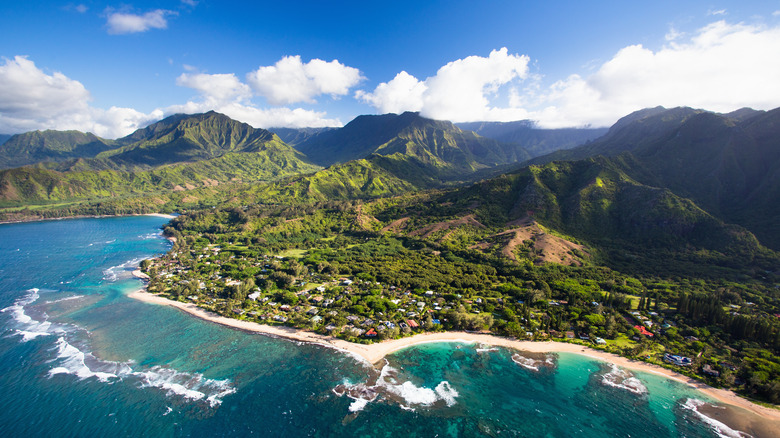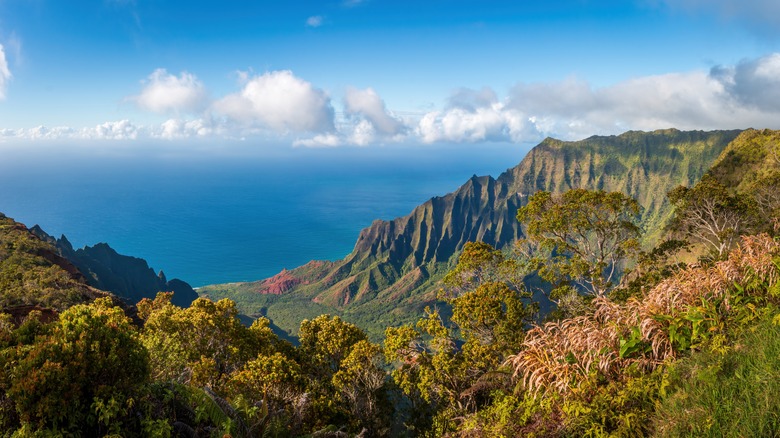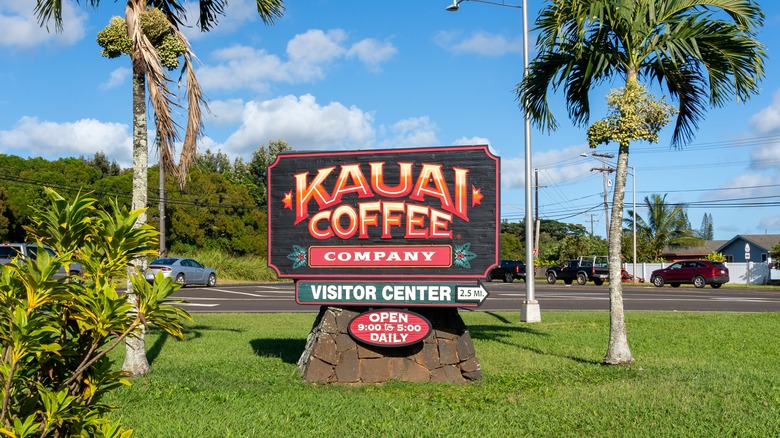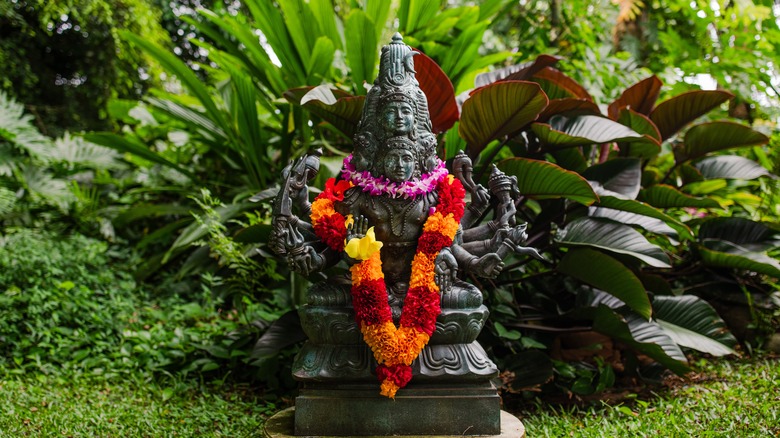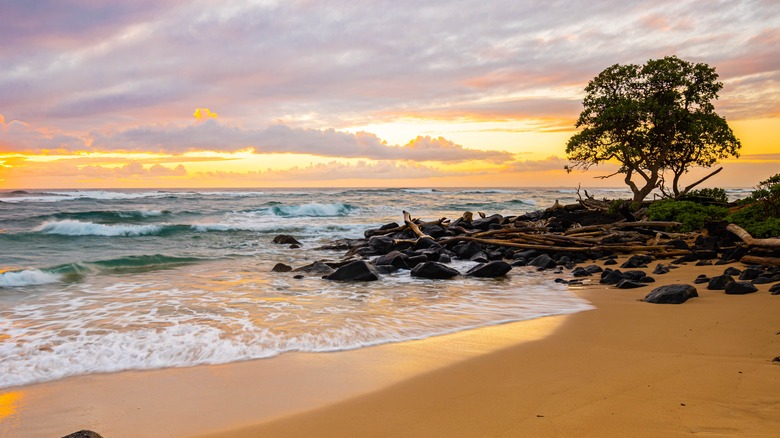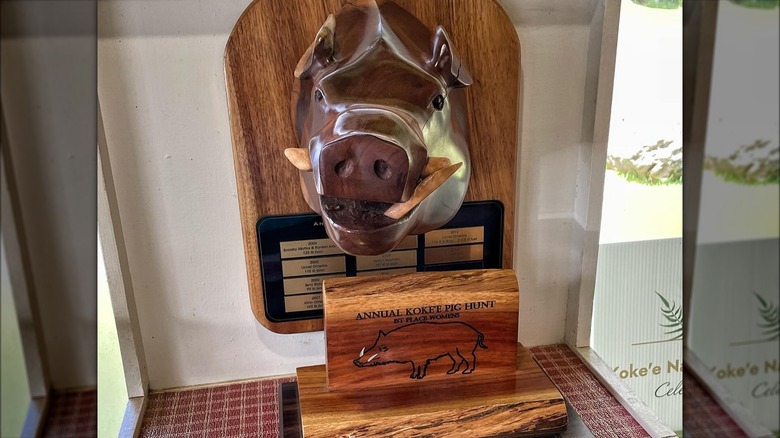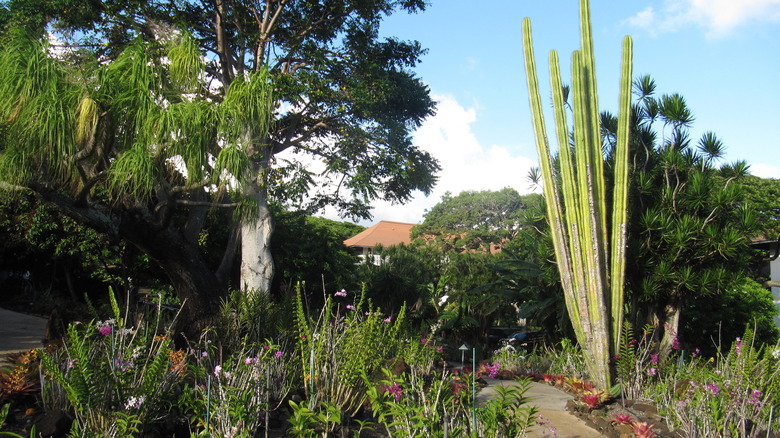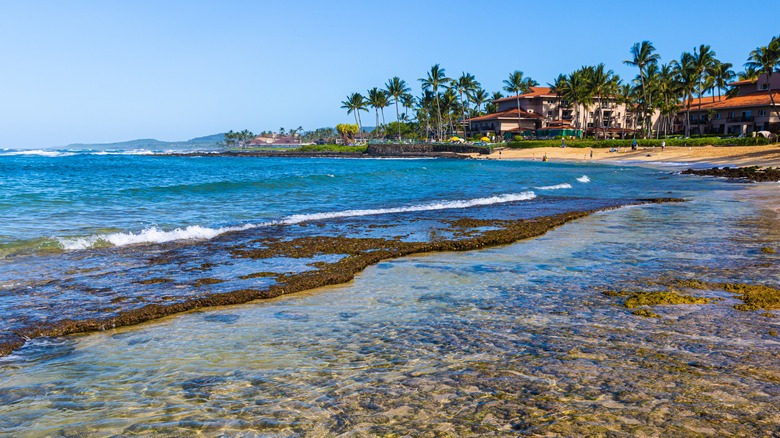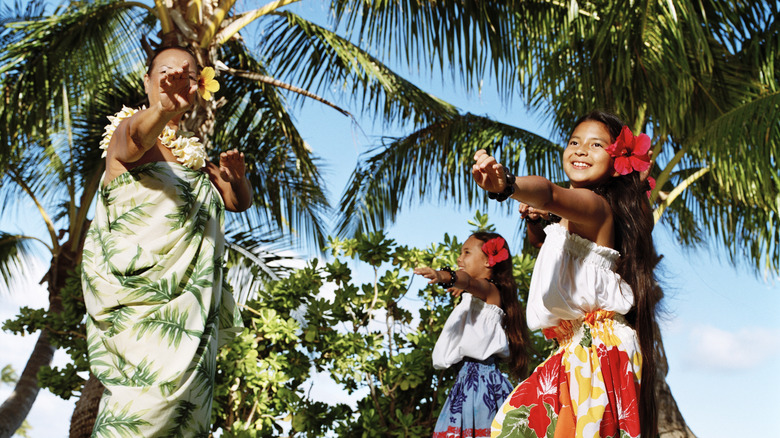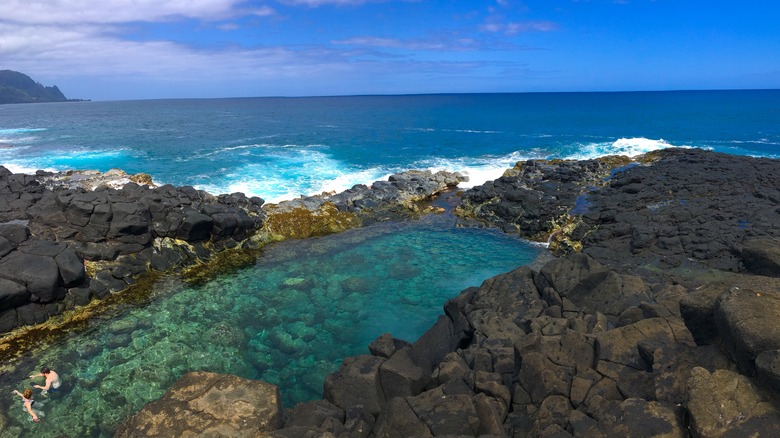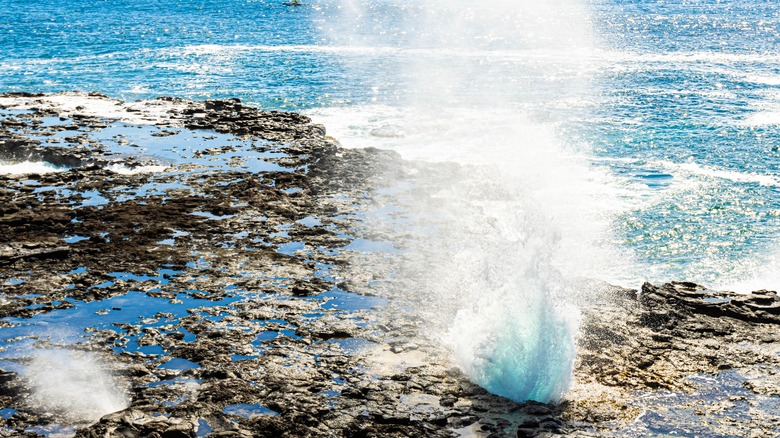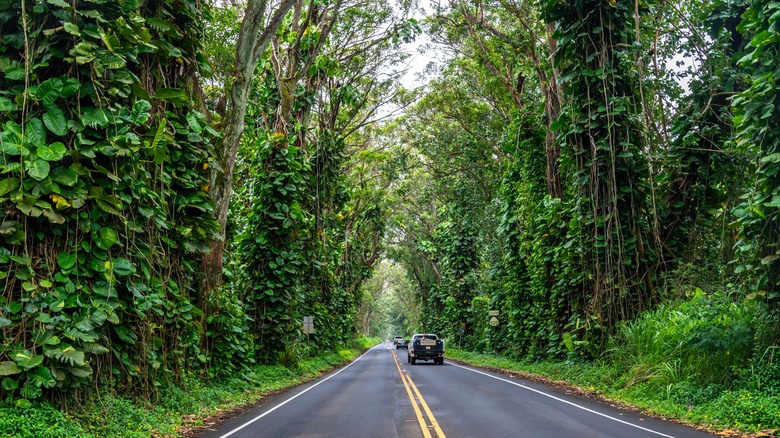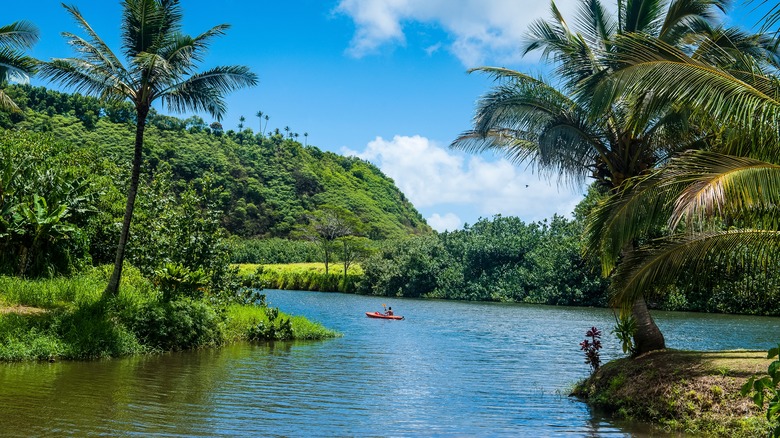The Best Free Things To Do In Kauai For An Unforgettable Trip
Kauai is a once-in-a-lifetime dream vacation for many people. Known as the "Garden Island," this tropical paradise is decked out with waterfalls, hiking trails, mountains, and beautiful beaches, and it isn't hard to see why it's been the setting of films like "Pirates of the Caribbean: On Stranger Tides," "Tropic Thunder," and "Avatar," all of which made good use of its otherworldly landscapes. However, luxury rarely comes cheap, and Kauai is no exception. Seven days on the island will run a couple an average of $3,234, and people can find themselves shelling out much more depending on their travel preferences.
The good news is you don't have to go broke going to Kauai — if you're strategic. The island is full of free fun, ranging from a loud blowhole caused by a natural lava tube to a natural tide pool with a noble name. We rounded up the best of the best that you can add to your itinerary to save a few bucks and still have the trip of a lifetime.
If you are looking for more ways to save dollars on your Hawaiian vacation, visit Kauai during the fall, when kids are back in school and wedding season is over. Prices are almost always lower at this time. Another tip is to reserve a rental car before you get to Kauai, as the island lacks affordable public transportation, and booking in advance is usually cheaper than doing so on arrival. There are also excellent budget-friendly resorts on the island. "Budget-friendly" isn't free, of course, so let's get to the good stuff.
Kalalau Lookout
You likely had to shell out a few bucks to see hit movies like "King Kong" and "Jurassic Park," but you won't need to pay a dollar to see the same views of Waimea Canyon and the Na Pali Coast featured in those films. That's because these flicks were set at Kalalau Lookout in Koke'e State Park, an observation point at 4,000 feet in the air — the highest elevation in Kauai by road — that offers scenery of the widest valley on the island.
The lookout is one of the most popular spots to take photos in the entire state, and you can put your feet to work to get a shot at this landmark. The hiking trail to get here is 11 miles long, and many people — half a million every year — tackle it to see the lookout in all its glory. Alternatively, visitors can drive there and park in an onsite parking lot.
No matter your method of travel, it's a good idea to start your journey to Kalalau Lookout early. The best time to reach it is before 11 a.m. when clouds are less likely to cover the ocean views. Once you're here, spend a few minutes traversing the lookout to see its various vantage points and also read about it on the informational sign. These are the sort of views people would gladly pay for, but the Kalalau Lookout doesn't cost a dollar.
Kauai Coffee Company's free tour
A cup of joe always has a price tag, and for those with an every-morning habit, it can certainly add up. However, seeing the coffee trees that supply Kauai Coffee Company and learning about the coffee-making process won't cost a cent. Kauai Coffee Company offers free, self-guided tours of its grounds, saving you the $30 to $50 it costs for a guided tour of the property while still providing information on how the coffee is grown and harvested. At the end, you'll be rewarded with picturesque views of the biggest coffee farm in the country, more than 3,000 acres of rolling fields upon volcanic earth, and the incomparable Pacific Ocean. The farm has been a staple of the island since the 1800s when it was founded as McBryde Sugar Company before transforming into Kauai Coffee Company in 1987. It now makes coffee with sustainability and the environment in mind, all while producing 100% Hawaiian beans.
Still jonesing for that cup of coffee? You can get a free bag of coffee beans on Wednesdays at Kauai Coffee Company and also try your hand at getting a free lunch. Every Wednesday from 9 a.m. to noon, the coffee farm hosts a free scavenger hunt where teams compete to finish a set of challenges. Every team who participates receives a free bag of coffee, while the first five teams to finish the hunt receive free lunch.
Kauai's Hindu Monastery
With its endless greenery, beautiful natural wonders, and spectacular waters, it's no surprise that many people find the peace they're craving when they visit Kauai. But they can find even more tranquility — for free — at Kauai's Hindu Monastery, officially known as Kauai Aadheenam. Visitors are welcome to wander the monastery's 363 acres near the Wailua River, bask in its gardens, waterfall, and pond, and look out at views of more than 50 more waterfalls and a temple between 9 a.m. and noon.
Kauai's Hindu Monastery is also home to a massive banyan tree, a sculpture of a six-faced god, and other sculptures surrounded by nature, as well as a visitor's center and informational panels so you can learn about Hinduism and the monastery. However, don't show up in shorts, short dresses, t-shirts, tank tops, or yoga pants, as you will be asked to cover up with a sarong for modesty if you do.
The monastery has been a center for Hinduism on the island since 1970, when a Californian man visited India and Sri Lanka and became enthralled by the religion. He founded the first Hindu temple in the United States in San Francisco before founding Kauai's Hindu Monastery. These days, it's the home of 19 monks from five countries. Entirely self-sufficient, they grow their own food, surrounded by more than 500 types of palms and Indian plants meaningful for Hindu worship.
Ke Ala Hele Makalae
Whether you're a history buff, you want to get your steps in, you want to see wild whales, or you just want to enjoy the view, there's an endless list of fun awaiting at the free Ke Ala Hele Makālae, an 8.5-mile paved trail with a name that means "the Path that Goes by the Coast" in Hawaiian. The trail runs along a former sugarcane railway and has plenty of meaningful stops along the way, such as Lydgate Park, an ideal spot for swimming and snorkeling thanks to the still waters in its lagoons. Those with a thirst for knowledge can find everything they need to know about the area here thanks to the plethora of archaeological, historical, and environmental signage, while families will also love the nearby bike rental shops that allow those of any age to traverse the trail with ease (and peace of mind, as the trail is separate from the major roads).
With tons of access points, Ke Ala Hele Makālae also allows people to "choose their own adventure," going as short or far of a distance as they wish. Due to all there is on the sole coastal bicycle and pedestrian path in Kauai, the more distance the merrier; there are tons of unique plants and animal species to see both on the ground and in the neighboring ocean.
Kokeʻe Natural History Museum
To learn more about Kauai before embarking on your itinerary (and save a few bucks), visit the free Kokeʻe Natural History Museum, which also acts as Koke'e State Park's visitor center. The museum is packed with historic photos, maps, exhibits on Kauai's native plants, botanical prints dating back to 1885, and taxidermized native animals. If you're looking to learn more about Kauai, there's no better place.
As the state park's visitor center, you can also learn about the park's hiking trails here. If you do want to splurge, the building also contains a gift shop where you can purchase books, local artwork, jewelry, t-shirts, and other things to remember your trip to Kauai. The park is open 365 days per year from 9 a.m. to 4:30 p.m., so no matter when you're visiting Kauai, you can fit this museum into your schedule. To extend your stay here, you can also camp at Koke'e State Park by obtaining a camping permit, although this must be done in advance.
Koloa Heritage Trail
The best way to see and learn about the iconic cultural, historical, and geological sites of Kauai's south shore is the free, self-guided, 10-mile Koloa Heritage Trail. On this trail, which can be explored on foot, by car, or by bike, visitors can explore various sites. When traversing the Koloa Heritage Trail, which is also known as Ka Ala Hele Waiwai Ho'oilina o Kōloa, travelers will see Hanakaape Bay, one of the best spots for snorkeling on the island, so bring your snorkel mask to see its bustling reef in action (Kauai is known for unmatched snorkeling).
Another gorgeous landmark on the trail is Moir Gardens, which honors both the gods of hula and rain in a colorful garden full of hard-to-find plants. To extend your Koloa Heritage Trail hike, visit the Pu'uwanawana Volcanic Cone, a greenery-covered cone formed by a volcanic eruption that is now ideal for a hike and stellar views. End your trip at the Yamamoto Store & Koloa Hotel, a turn-of-the-20th-century general store that is now a popular souvenir shop.
Poipu Beach Park
Americans are used to shelling out money for beach access, especially if the beach has lifeguards, bathrooms, showers, picnic tables, shade, and lawns for games. However, they won't have to pay a cent to visit Poipu Beach Park on the south coast of Kauai. This Hawaiian beach is not only free, but it's also one of the best beaches for swimming on the island. It was even once called the best beach in the country. With beautiful blue water, it contains tons of natural features, like a shallow keiki pool that is great for kids and often has a few visiting turtles, Hawaiian monk seals, and other marine animals.
Love to surf? Poipu Beach Park is the place to be. Although one side of the beach — separated by a rocky sandbar — has calm waters and is ideal for swimming, the other side has big waves perfect for surfing and bodyboarding that attract surfers from across the world. Surfboard and bodyboard rentals are also available depending on the season. With coral reefs just under the water, people can also snorkel at Poipu Beach Park and meet the many sea creatures that call the Pacific home. Finally, end your day at Poipu Beach Park by watching the sunset go down, or extend your trip by staying at one of its lodging options.
Hula shows at Poipu Shopping Village
It's hard to keep your wallet in your pocket at Poipu Shopping Village, which has a ton of varied Hawaiian-themed retail shops ranging from Cariloha Bamboo (the only shop on the planet to solely sell items made from bamboo) to Making Waves, which sells more swimwear than any other store in the state. However, to enjoy the outdoor mall's free live hula shows every Thursday at 5 p.m., you don't have to pay a dime.
Each week on the mall's center stage, Keola Worthington sings and shares stories about Hawaiian life set to hula dance by members of the hula school Halau Ka Lei Mokihana O Leina`ala. As the school regularly performs sold-out shows throughout the island, the Poipu Shopping Village performances are a great way to see authentic hula for free. Can't make it on a Thursday afternoon? Bangkok Happy Bowl and Sushi Bar (a restaurant in the mall) also presents free live hula shows every night from 6 p.m. to 8:30 p.m., although you'll have to purchase a meal and snag a table to enjoy it.
Queen's Bath
Queen's Bath — a large natural saltwater tide pool on the north shore of the island — may have a royal name, but it doesn't have any noble history. However, with its deep-blue beauty, abundance of tropical creatures, and stunning surrounding cliffs formed by hardened lava, it's clear why this pool is fit for a queen. To get to this Princeville landmark, visit early to beat the crowd — and the full parking lot — before hiking about 10 minutes and then another five over rocks that can sometimes be slippery.
A visit to Queen's Bath is one that needs caution. People should only enter the pool from June through September when the water is under 4 feet high. During the colder months, large waves pummel the pool, and several people have drowned here as a result of the strong tide. Potential visitors should only visit the pool after checking the day's weather and surf report to ensure safety, as massive waves can strike the pool (and its inhabitants) at any time.
If the weather is poor, then try these rainy-day activities in Kauai. However, if you're lucky enough to visit during low tide and calm conditions, a visit will yield excellent snorkeling opportunities, beautiful photos, and a relaxing lounge on the rocks. It'll only cost you that slippery stroll.
Spouting Horn
Queen's Bath isn't accessible during high tide, but Spouting Horn is one Kauai natural wonder that's best visited when the Pacific is at its strongest. As the waves smash the coast, they land on a lava shelf, pushing water through a rock opening, creating a 50-foot spout that's one of the most photographed features of the island. It also makes a sound that is the stuff of legends. As the story goes, the roar created by the spout comes from a lizard named Kaikapu, who once fiercely guarded the shore but got stuck in the rock opening after being outsmarted by a boy named Liko.
To reach Spouting Horn, drive to Koloa on the south shore of Kauai and park in the free lot. The best time to visit — besides when the tide is high — is at sunset when you can watch the sun go down behind the spout. Or, head there between November and May, when humpback whales can be seen in the area. No matter when you visit, steer clear of the water and stay behind the safety railings since the waves can be large and the coast can be slippery. It's not the only spot that can be scary; Hawaii's beaches are some of the most dangerous in the world.
Tree Tunnel
On your way to the Koloa Heritage Trail and the south shore of the island, you'll enjoy a grand yet free entrance with the 3-mile Tree Tunnel, which contains two rows of over 500 Eucalyptus trees that have been a part of the Kauai landscape for over a century. Walter McBryde — co-founder of a local sugar company and manager of a local pineapple company — gave the trees to the island as he did not need them for his estate, which is now where Kukuiolono Park and Golf Course stands. Today, there is a 100-foot canopy shielding Maliuhi Road, which fittingly means "serenity" in Hawaiian. The scene is so beautiful that it even shines at night, when the light of the moon pops through the branches.
But it hasn't always been easy to maintain the serene vibes of the trees. Two hurricanes nearly destroyed them, including Hurricane Iniki, which, in 1992, brought 225-mph gusts that pounded the trees. It took two decades of work to restore them to their original splendor.
Wailua River State Park
Kauai is full of natural beauty, but one of the most accessible (and cheapest) ways to see it is by visiting the free Wailua River State Park, home to the only navigable river in the state and tons of waterfalls. One of the best ways to explore the park's namesake river is by kayak or traditional Hawaiian canoe, which can lead you to Fern Grotto. As the name implies, this is a cavern covered in ferns for a whimsical and romantic vibe.
Alternatively, boat to Secret Falls (otherwise known as Uluwehi Falls), a 100-foot waterfall and natural pool that is a 20-minute hike from the river. Another popular waterfall to see in the park is Wailua Falls, a 170-foot-plus cascade with amazing strength that is spotlighted in the opening credits of the TV show "'Fantasy Island."
Wailua River State Park isn't just for nature exploration. The park is also a cultural epicenter. The river is sacred to the native people, so various shrines and developments have been constructed here. Those include the Wailua Complex of Heiau, a National Historic Landmark that once acted as the capital of Kauai and contains historic places of worship, rock carvings, and birthstones.
